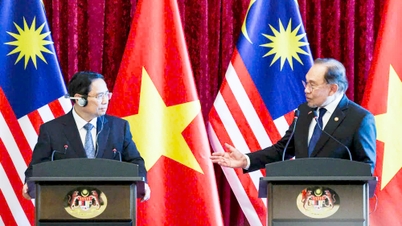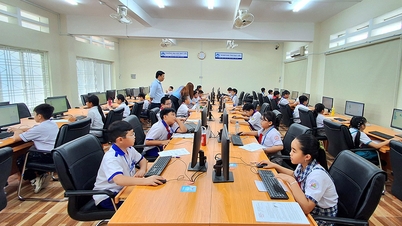Ministry of Industry and Trade activates 6 groups of solutions to ensure electricity for growth
Sharing at the seminar "Ensuring electricity for growth - Requirements and solutions" organized by the Government Electronic Information Portal on the morning of May 7, Mr. Doan Ngoc Duong - Deputy Director of the Department of Electricity and Renewable Energy (Ministry of Industry and Trade) said that based on the target of a minimum economic growth of 8%, electricity demand is forecast to grow by over 12% according to the scenario set by the Ministry of Industry and Trade for management.
|
Mr. Doan Ngoc Duong - Deputy Director of Electricity Department shared at the seminar. |
Specifically, the Ministry of Industry and Trade has developed operational scenarios and directed the entire electricity sector to promptly deploy 6 key solution groups to ensure stable electricity supply.
The first solution is to require power plants and transmission and distribution units to ensure maintenance and repair on schedule, keeping equipment in the highest state of readiness.
The second is to proactively reserve fuel (coal, oil, gas) at factories and warehouses for peak periods.
Third, the Ministry will especially promote the progress of key power source and grid projects, such as: Hoa Binh Hydropower Plant Expansion, Nhon Trach 3,4 Thermal Power Plants, and Lao Cai - Vinh Yen 500kV grid (expected to be operational on the occasion of National Day, September 2).
The fourth solution is to develop and update flexible dispatch scenarios to be ready to respond to fluctuations in load, weather, and unusual hydrological conditions. Fifth, promote energy saving and reduce load during peak hours. Sixth, strengthen monitoring of the entire chain from generation to transmission, dispatch, and distribution to ensure smooth operation and quick response to incidents.
Mr. Duong affirmed: "With the groups of solutions that have been and are being deployed, up to now, the Ministry of Industry and Trade believes that the electricity supply for 2025 will basically be guaranteed, if the forecast conditions do not fluctuate too extreme."
However, he also admitted that a response scenario is still needed in unusual cases, such as sudden load increases, prolonged hot weather, or generator failures due to continuous full-load operation.
Electricity prices need to be transparent, not including social security in the price mechanism.
Although the electricity industry has been proactive in many aspects, according to experts, the current electricity price mechanism is still a major bottleneck, threatening to weaken the capacity for reinvestment and attracting resources for industry development.
According to Mr. Nguyen Tien Thoa - former Director of the Price Management Department (Ministry of Finance): "Current electricity prices do not follow market mechanisms, are not calculated correctly and fully for input costs, the situation of buying high and selling low has existed for many years but has not been completely resolved".
|
Former Director of the Price Management Department Nguyen Tien Thoa (middle) shared at the seminar. |
He said that the current electricity price bears too many goals at the same time, from supporting investment, controlling inflation, ensuring social security to encouraging electricity saving, leading to conflicting goals that are difficult to reach consensus on and implement effectively.
Notably, the mechanism of cross-subsidizing electricity prices between consumers and producers, between regions... has been maintained for too long, distorting the electricity market, causing retail prices to not reflect the true value of 1 kWh of electricity. "Electricity has become a subsidized commodity for the whole society, eliminating the motivation to save and hindering investment attraction in the electricity industry," said Mr. Thoa.
Therefore, Mr. Thoa proposed that it is necessary to completely switch to operating electricity prices according to the market mechanism, by correctly and fully calculating costs in electricity prices and amending the current electricity price list to overcome existing shortcomings. According to him, the current price calculation formula should eliminate the item "other costs", because in fact these are expenses that have not been fully calculated, and are often gradually allocated, such as costs due to exchange rate differences.
According to him, if a market mechanism is applied, electricity prices need to be clearly composed of specific costs such as generation, transmission, retail, management, etc., and at the same time must ensure a reasonable profit level so that the electricity industry can reinvest and develop sustainably.
In addition, Mr. Thoa also proposed to eliminate the cross-subsidy mechanism in electricity prices, and instead develop separate support policies suitable for each region and target group. In particular, it is necessary to separate the social security factor from the electricity price structure, to avoid price distortion due to too many targets.
“We do not abandon social security policies or abandon the disadvantaged. However, to ensure that all people have access to basic electricity services, we need to use direct support policies, instead of mixing them into electricity prices. This separation, if achieved, will be very beneficial for the electricity industry, creating conditions to ensure stable electricity supply to serve economic growth as the Government and the National Assembly have set out,” Mr. Thoa emphasized.
|
Energy expert Ha Dang Son. |
Regarding electricity prices, energy expert Ha Dang Son said that when compared to other countries in the region, Vietnam's average electricity price is currently at the same level as China and India, higher than Bangladesh and Malaysia - countries with their own advantages in hydropower or domestic oil and gas. On the contrary, many other countries such as Indonesia, Thailand, Singapore, and the Philippines have higher electricity prices than Vietnam. In Singapore alone, electricity prices are now approaching those of Japan; and in Thailand, after reforming the electricity price mechanism towards hourly calculation, electricity prices have increased sharply and are about 50% higher than Vietnam compared to 3-4 years ago.
According to Mr. Son, the problem is not whether electricity prices increase or decrease, but how to make electricity prices reflect the true nature of production costs, ensuring stability and sustainability in investment and operation of the national power system.
Many developed countries are also gradually shifting to a market mechanism in setting electricity prices - transparent, fully factoring in costs and linked to the trend of investing in clean energy.
If Vietnam maintains electricity prices lower than actual costs for a long time, it may create a temporary competitive advantage for production or social security. However, this poses a risk of imbalance in infrastructure investment, does not ensure stable electricity supply, and is unsustainable in the long term.
Mr. Ha Dang Son emphasized that the fundamental solution is to have a roadmap for adjusting electricity prices in a reasonable, transparent, and market-oriented manner, fully reflecting the constituent costs, while still ensuring that it does not create a price “shock” for the people and the economy. “The balance between marketizing electricity prices and social stability is a difficult problem but must be solved,” said Mr. Son.
Source: https://baophapluat.vn/nganh-dien-tang-toc-chuan-bi-cho-tang-truong-8-chuyen-gia-de-xuat-sua-co-che-gia-dien-post547638.html





![[Photo] Prime Minister Pham Minh Chinh receives a bipartisan delegation of US House of Representatives](https://vphoto.vietnam.vn/thumb/1200x675/vietnam/resource/IMAGE/2025/5/28/468e61546b664d3f98dc75f6a3c2c880)
![[Photo] Prime Minister Pham Minh Chinh meets with Hungarian President Sulyok Tamas](https://vphoto.vietnam.vn/thumb/1200x675/vietnam/resource/IMAGE/2025/5/29/dbcaa73e92ea4448a03fe1d0de6d68e8)
![[Photo] Vietnamese and Hungarian leaders attend the opening of the exhibition by photographer Bozoky Dezso](https://vphoto.vietnam.vn/thumb/1200x675/vietnam/resource/IMAGE/2025/5/29/94d8ceca5db14af3bf31285551ae4bb3)






















































































Comment (0)